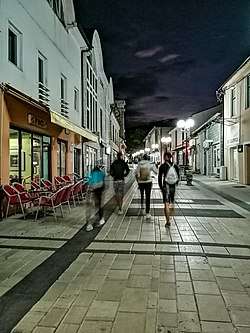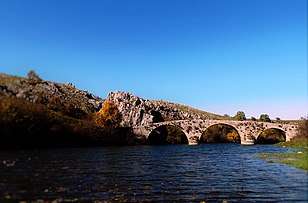Nevesinje
Nevesinje (Serbian Cyrillic: Невесиње) is a town and municipality located in the Republika Srpska entity of Bosnia and Herzegovina. As of 2013, the town has a population of 5,464 inhabitants, while the municipality has 12,961 inhabitants.
Nevesinje Невесиње | |
|---|---|
Town and municipality | |
 Nevesinje | |
.svg.png) Coat of arms | |
 Location of Nevesinje within Republika Srpska | |
| Coordinates: 43°15′30″N 18°6′48″E | |
| Country | Bosnia and Herzegovina |
| Entity | Republika Srpska |
| Geographical region | East Herzegovina |
| Boroughs | 56 (as of 1991) |
| Government | |
| • Village Elder | Milenko Avdalović (SNSD) |
| • Municipality | 923.04 km2 (356.39 sq mi) |
| Population (2013 census) | |
| • Town | 5,464 |
| • Municipality | 12,961 |
| • Municipality density | 14/km2 (36/sq mi) |
| Time zone | UTC+1 (CET) |
| • Summer (DST) | UTC+2 (CEST) |
| Area code(s) | 59 |
| Website | opstinanevesinje |
Geography and climate
Geography
The municipality of Nevesinje covers 1,040 km2 (402 sq mi) and is located in southern part of Bosnia and Herzegovina. A large polje called Nevesinjsko polje dominates the municipality, and is encircled by mountains of Crvanj at the north-northeast, Prenj at the northwest, and Velež at the south-southwest. The entire municipality, as well as the entire region of eastern Herzegovina beyond municipal borders, is an elevate at the average 860 metres (2,820 ft) above the sea level.
History
The annals of the Patriarchal Monastery of Peć mentioned Nevesinje in 1219, which is the earliest appearance of Nevesinje in preserved historical sources. The župa (county) of Nevesinje was held by Serbian prince Stefan Konstantin between 1303–06.[1][2]

The region was under the rule of different medieval lords until the end of the 15th century. The most significant ruler of Nevesinje from this period was Stjepan Vukčić Kosača, known as Herceg Stefan. The whole land Hercegovina was named after him. His lands were under the constant threat from advancing Turkish forces in the 15th century. Hercegovina, and thus Nevesinje were gradually incorporated into the Turkish Empire by the first quarter of the 15th century (1422).
Under the Ottoman Empire, Nevesinje was mostly part of Bosnian Pashaluk and was a seat of a qadi. The Great Eastern Crisis was ignited at Nevesinje, with the outbreak of the Herzegovinian rebellion of 1875–78 when Serbs of the region rebelled against Turkish tax collectors. The rebellion soon spread to the rest of Herzegovina and to Bosnia and other parts of the Ottoman Empire.
Neighbouring states, Serbia, Montenegro and Bulgaria got involved in the conflict which in turn pulled in great powers of the time. The conflict ended with Congress of Berlin in 1878 and the province of Bosnia and Herzegovina was placed under the administration of Austria-Hungary. At the same time Romania, Serbia and Montenegro were declared independent principalities.
In 2019, Nevesinje experienced a power outage that was named one of the worst crises in the country of Bosnia.
Settlements
Aside from the village of Nevesinje, there are 55 other settlements that comprise the municipality:
- Batkovići
- Bežđeđe
- Biograd
- Bojišta
- Borovčići
- Bratač
- Budisavlje
- Donja Bijenja
- Donji Drežanj
- Donji Lukavac
- Dramiševo
- Gaj
- Gornja Bijenja
- Gornji Drežanj
- Gornji Lukavac
- Grabovica
- Hrušta
- Humčani
- Jasena
- Jugovići
- Kifino Selo
- Kljen
- Kljuna
- Kovačići
- Krekovi
- Kruševljani
- Lakat
- Luka
- Miljevac
- Odžak
- Plužine
- Podgrađe
- Postoljani
- Presjeka
- Pridvorci
- Prkovići
- Rabina
- Rast
- Rilja
- Rogače
- Seljani
- Slato
- Sopilja
- Studenci
- Šehovina
- Šipačno
- Trtine
- Trusina
- Udrežnje
- Zaborani
- Zalom
- Zalužje
- Zovi Do
- Žiljevo
- Žuberin
- Žulja
Demographics
Population
| Population of settlements – Nevesinje municipality | ||||||||
|---|---|---|---|---|---|---|---|---|
| 1948. | 1953. | 1961. | 1971. | 1981. | 1991. | 2013. | ||
| 23,820 | 20,474 | 19,333 | 16,326 | 14,448 | 12,961 | |||
| 1 | Batkovići | 262 | 346 | |||||
| 2 | Biograd | 507 | 495 | |||||
| 3 | Bojišta | 546 | 659 | |||||
| 4 | Bratač | 354 | 240 | |||||
| 5 | Krekovi | 356 | 340 | |||||
| 6 | Miljevac | 390 | 1,001 | |||||
| 7 | Nevesinje | 1,615 | 2,349 | 3,055 | 3,605 | 4,068 | 5,464 | |
| 8 | Šehovina | 413 | 598 | |||||
| 9 | Zalužje | 332 | 222 | |||||
| 10 | Žiljevo | 355 | 471 | |||||
| 11 | Zovi Do | 422 | 293 | |||||
Ethnic composition
| Ethnic composition – Nevesinje town | |||||||
|---|---|---|---|---|---|---|---|
| 2013. | 1991. | 1981. | 1971. | ||||
| Total | 5,464 (100,0%) | 4,068 (100,0%) | 3,605 (100,0%) | 3,055 (100,0%) | |||
| Serbs | 3,247 (79,82%) | 2,622 (72,73%) | 2,268 (74,24%) | ||||
| Bosniaks | 634 (15,59%) | 593 (16,45%) | 642 (21,01%) | ||||
| Yugoslavs | 104 (2,557%) | 304 (8,433%) | 25 (0,818%) | ||||
| Others | 44 (1,082%) | 4 (0,111%) | 10 (0,327%) | ||||
| Croats | 39 (0,959%) | 59 (1,637%) | 91 (2,979%) | ||||
| Montenegrins | 13 (0,361%) | 12 (0,393%) | |||||
| Albanians | 6 (0,166%) | 4 (0,131%) | |||||
| Slovenes | 4 (0,111%) | 3 (0,098%) | |||||
| Ethnic composition – Nevesinje municipality | |||||||
|---|---|---|---|---|---|---|---|
| 2013. | 1991. | 1981. | 1971. | ||||
| Total | 12,961 (100,0%) | 14,448 (100,0%) | 16,326 (100,0%) | 19,333 (100,0%) | |||
| Serbs | 12,353 (95,31%) | 10,711 (74,13%) | 11,587 (70,97%) | 14,479 (74,89%) | |||
| Bosniaks | 533 (4,112%) | 3,313 (22,93%) | 3,853 (23,60%) | 4,370 (22,60%) | |||
| Others | 47 (0,363%) | 91 (0,630%) | 26 (0,159%) | 37 (0,191%) | |||
| Croats | 28 (0,216%) | 210 (1,453%) | 276 (1,691%) | 384 (1,986%) | |||
| Yugoslavs | 123 (0,851%) | 539 (3,301%) | 28 (0,145%) | ||||
| Montenegrins | 34 (0,208%) | 28 (0,145%) | |||||
| Albanians | 6 (0,037%) | 4 (0,021%) | |||||
| Slovenes | 4 (0,025%) | 3 (0,016%) | |||||
| Macedonians | 1 (0,006%) | ||||||
Economy
The following table gives a preview of total number of registered people employed in legal entities per their core activity (as of 2018):[3]
| Activity | Total |
|---|---|
| Agriculture, forestry and fishing | 106 |
| Mining and quarrying | 5 |
| Manufacturing | 159 |
| Electricity, gas, steam and air conditioning supply | 50 |
| Water supply; sewerage, waste management and remediation activities | 66 |
| Construction | 119 |
| Wholesale and retail trade, repair of motor vehicles and motorcycles | 280 |
| Transportation and storage | 56 |
| Accommodation and food services | 120 |
| Information and communication | 20 |
| Financial and insurance activities | 19 |
| Real estate activities | 2 |
| Professional, scientific and technical activities | 27 |
| Administrative and support service activities | 8 |
| Public administration and defense; compulsory social security | 169 |
| Education | 223 |
| Human health and social work activities | 155 |
| Arts, entertainment and recreation | 52 |
| Other service activities | 42 |
| Total | 1,678 |
Transport
Nevesinje has a bus station and daily buses head from Nevesinje to Podgorica, Montenegro via the towns Gacko, Bileća and Trebinje within Bosnia and Herzegovina, and Nikšić and Danilovgrad within Montenegro. Local buses link the town with Mostar. The town also has direct buses to Dubrovnik and Belgrade.
Notable people
- Safvet-beg Bašagić, writer
- Borislav Arapović, poet, linguist, literary scholar
- Dražen Bogopenec, was a county lord (župan) in Zagorje
References
- Ljubo Mihić (1975). Ljubinje sa okolinom. Dragan Srnic. p. 117.
- Obrad Mićov Samardžić; Mirjana Samardžić; Saša Samardžić; Aleksandra Samardžić (2006). Svadbe i pogrebni običaji pravoslavnih u Nevesinju. Čigoja štampa. p. 11.
први познати господар жупе Невесиње спомиње се Константин Немањић (1303-1306)
- "Cities and Municipalities of Republika Srpska" (PDF). rzs.rs.ba. Republika Srspka Institute of Statistics. 25 December 2019. Retrieved 31 December 2019.
Sources
- Kapidžić, dr Hamdija: Hercegovački ustanak 1882.godine, Sarajevo, "Veselin Masleša", 1958.
External links
| Wikimedia Commons has media related to Nevesinje. |